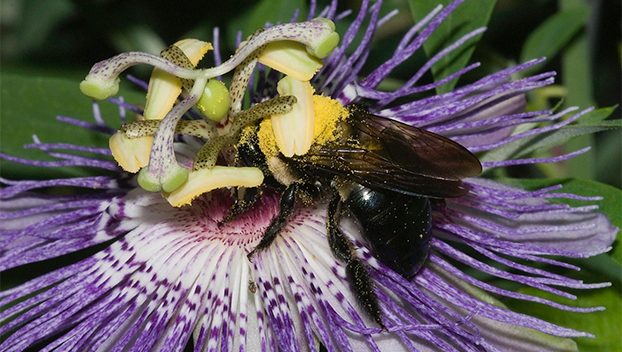Dealing with carpenter bees
Published 3:08 pm Thursday, April 8, 2021

- Photo submitted by Gene Fox.
|
Getting your Trinity Audio player ready...
|
My daughter was out playing this past week on the beautiful wooden play set we bought from Salt Wood Products. That thing took me hours of sweat and blood to put together. As she was playing on it, blowing bubbles from the top and watching them waft along in the breeze, she began to scream. I had no idea what about until I got there and she was being swarmed by carpenter bees. Those bumble looking bees that seem to always be hovering around in the summertime.
They can be distinguished from bumble bees by looking at the shiny black tail section. They can often be seen hovering around porches, houses, and especially wooden barns like the one at my house. They are yellow and black and tend to be large in size for a bee. One thing I always tell my children is that they don’t sting, but this is not entirely true. Females have stingers but tend not to use them unless they are trapped in your hand. Males on the other hand tend to be really aggressive in swarming your head but do not have stingers. So, a lot of bark but no sting in this case. Males can be distinguished from females by the whitish spot on the front of their face.
Also contrary to popular belief, carpenter bees do not eat wood. They excavate holes for nesting as a solitary bee species. The female will tunnel in about ½” and then follow the grain of the wood creating galleries. These galleries typically extend 6”-7” but may be as long as a foot. Inside the gallery the female deposits a mixture of pollen and nectar that will serve as food for her emerging eggs. She then deposits the eggs near this ball and seals this section off with chewed wood. The female will continue to make these cells until the tunnel is completely filled. The bees die in a matter of a few weeks. The new adults emerge and continue the cycle throughout the season having several generations.
The bees can create a bit of damage over the course of several years, eventually harming the structural integrity of the wood and exposing it to the elements. Painted and salt treated wood can be deterrents but bees will still tunnel into them. Pest resistant wood such as redwood or cypress is by no means immune to attack either. Another issue is the excrement from the bees as they enter their tunnels. It causes yellow staining to the wood on porches and homes.
So what to do? Control is very difficult because the carpenter bees do not eat the wood. Pesticides sprayed into the holes can cause a bit of trouble for them but often they will not be exposed to enough to be lethal. Treating holes with powdery products such as those containing carbaryl (the active ingredient in Sevin and other products) can be the most effective at reducing future nesting activity. Sprays do not have a long enough residual effect to be worth the time to treat with them. Seal the hole with a ball of aluminum foil for 24-36 hours and then caulk it shut. Caulking it shut will deter other carpenter bees from nesting in that hole and prevent water damage. Plugging holes with wire or mesh is ineffective, bees will often just tunnel another exit.
Mike Waldvogal, NCSU Entomologist, says that swatting them with a tennis racket can be just as effective and possibly therapeutic. Remember folks, these are pollinators as well, harvesting nectar and moving pollen, so try not to swat too many.
The Extension Master Gardener Volunteers will continue to have their vegetable plant sale Saturday, April 10 from 9 a.m. to 12 p.m. They will have another sale the next week when the peppers are ready on Wednesday, April 14 and Saturday, April 17 from 9 a.m. to 12 p.m both days or until supplies last. They will have Tomatoes, Squash, and Cucumbers for sale that were propagated right here at the Extension Center. The plants always go really fast so my advice would be not to wait, they sold nearly half of their stock this past Wednesday.
Our third Lunch & Learn was this past Thursday on managing pest & disease in cool season crops. Next Thursday, April 15, we will be talking about harvesting our cool-season crops. You can register for this series by visiting go.ncsu.edu/saladinabucket. There are only three sessions left, each on the subsequent Thursday at noon. Over the course of our thirty minutes together on zoom, we will go through the How To’s of growing your own salad in a series of five-gallon buckets. The program should take 15-20 minutes leaving 10-15 minutes for questions.
If you are having an issue in your home garden or landscape, send your questions to Gene Fox, Consumer Horticulture Agent with the North Carolina Cooperative Extension Service, please email at Gene at gene_fox@ncsu.edu or call at (252)946-0111. Learn more on Facebook at the Blacklands Area Horticulture page or visit the Extension Office located at 155 Airport Road in Washington, NC.
Gene Fox is the area consumer horticulture agent with North Carolina Cooperative Extension.





